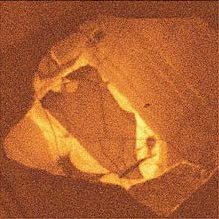Ancient Rock May Alter Theories of Earth History
New York Times, January 11, 2001
By KENNETH CHANG
|
![]() n
a grain-size crystal from western Australia, geologists have identified
the oldest piece of Earth yet discovered.
n
a grain-size crystal from western Australia, geologists have identified
the oldest piece of Earth yet discovered.
The find may lead scientists to reconsider theories about when life first appeared on the planet, as well as the origin of the Moon.
The geologists, who describe their discovery in today's issue of the journal Nature, said the crystal — a transparent pink speck of zircon only about as wide as a strand of human hair — crystallized 4.4 billion years ago, when Earth was a mere 150 million years old.
The oldest known rocks on Earth are about 4 billion years old, and another Australian zircon crystal had previously been dated at 4.28 billion years old.
The newly analyzed zircon sample, the international team of researchers say, provides evidence that the Earth was considerably less hot at that early stage of its development than previously thought — and even possessed oceans and continents much like those today.
"This gives our first glimpses of what the Earth was like shortly after it formed," said Dr. John W. Valley, a professor of geology and geophysics at the University of Wisconsin at Madison and an author of the Nature paper. "This is, by a large margin, the oldest piece of the Earth that has ever been found."
The crystal was culled from rocks taken from the Australian site, about 400 miles north of Perth, in 1984 and identified as 3 billion years old. In the rocks, the scientists found zircon crystals as old as 4.28 billion years.
More recently, Dr. Valley developed new techniques to analyze the oxygen within zircon crystals. "We said, wouldn't it be wonderful to analyze the oldest oxygen from the Earth?" he recalled.
Dr. Valley met one of the geologists who originally dug up the rocks, Dr. Simon A. Wilde at the Curtin University of Technology in Perth. In 1999, Dr. Wilde extracted more zircons from the 1984 rocks. One was the 4.4-billion-year-old crystal.
A second team of scientists dated other zircon crystals taken from the same site in 1999, finding one crystal 4.3 billion years old. Their report also appears in today's Nature.
Zircons are formed at high temperatures, from melted rocks. The ages of the crystals were determined, within a few million years, by measurements of the levels of uranium and lead trapped in the zircon. Over time, uranium decays into lead; the older a crystal is, the greater the fraction of lead it contains.
From analysis of oxygen atoms in the crystals, both groups also concluded that even during this early epoch, Earth's surface was cool enough for liquid water to condense. That finding may force a revision of ideas about how the Moon formed and how early life arose on Earth.
The most widely accepted theory about the Moon's origin is that about 4.5 billion years ago, an object the size of Mars slammed into Earth; the Moon, it is believed, formed from material that was thrown into space.
An impact of that size would have melted the outer shell of the Earth, creating an ocean of molten magma hundreds of miles deep.
But if the scientists' analysis of the crystal's age is correct, "it does challenge the view there was widespread magma ocean on the surface" at the time the crystal was formed, said Dr. T. Mark Harrison, a professor of geochemistry at the University of California at Los Angeles and an author of the second Nature paper.
The presence of water hinted by the crystal would mean that by 4.4 billion years ago, about 100 million years after the impact, temperatures had fallen from more than a thousand degrees Fahrenheit to less than the boiling point.
Some scientists wonder whether Earth could have cooled that quickly, and whether alternate theories for the Moon's origin may have to be revisited. But Dr. H. Jay Melosh, a professor of planetary sciences at the University of Arizona, said that the zircon crystal's age did not pose a problem for the collision theory.
With magma welling from Earth's interior to its surface, the planet could cool in a few tens of thousands of years, almost like a stirred cup of coffee, he said.
Others are not sure. "How fast is the Earth's mantle convecting?" asked Dr. John H. Jones, a planetary scientist at NASA. "Can it really get to the surface? Is there a thin crust that keeps the heat from getting out as quick? These are all things we don't know."
The crystals also suggest that the Earth's crust at that time was much like it is today. Some scientists have speculated that the planet's early surface might have resembled the Moon's crust or the present sea floor.
The possibility of oceans 4.4 billion years ago also puts a wrinkle into studies on the origin of life on Earth.
Current theories hold that the oceans formed less than 4 billion years ago, and that life on Earth started not long after that, perhaps 3.85 billion years ago. The prospect of oceans existing 400 million years earlier raises the possibility that life on Earth started much earlier too. Or, it might suggest that life took hundreds of millions of years longer to develop than now believed.
The three essential ingredients for life to begin are organic building blocks, energy and liquid water. The first two, most believe, were already present — organic molecules from comets that crashed into Earth and energy from sunlight and the heat from the planet's interior.
"Once you have liquid water, people think, `Could life have evolved?' " Dr. Valley said.
